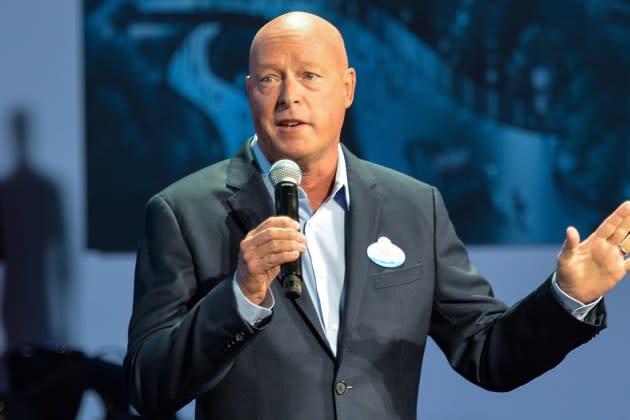Investors Sue Disney Over Alleged Chapek Era “Cost-Shifting Scheme” to Hide Streaming Losses
- Oops!Something went wrong.Please try again later.

As Disney stock hovers at its lowest levels in nearly a decade, the company was hit with another lawsuit alleging it misled investors about the success of Disney+ by concealing the true costs of operating the platform.
Disney is being accused of lying about the extent of its losses to hit lofty subscriber growth targets and claiming that the streaming service was on track to achieve profitability by the end of 2024. Investors detail a scheme to “inappropriately shift costs” by debuting content created for Disney+ on legacy platforms to move marketing and production costs.
More from The Hollywood Reporter
'Moving' Becomes Disney's Most Watched Korean Drama Ever in Just 7 Days
Disney Doubles Down on Florida Litigation Against Ron DeSantis' Board as Governor Signals White Flag
Writers Guild West Calls for Lawmakers to Look Into Disney, Amazon and Netflix Deals
The complaint filed on Aug. 23 in California federal court is at least the third taking issue with the company’s efforts to boost subscriptions for its streaming platform. It faces an identical investor suit over an alleged “cost-shifting scheme” in its streaming division and claims that it obstructed a deal between TSG Entertainment Finance and 20th Century Studios, which Disney owns, to “prop up” Disney+ and inflate its stock price.
The suit claims that company executives hid the expense and difficulty of maintaining subscriber growth as it suffered “staggering costs” to create content. In an effort to hide losses, the complaint claims, former chief executive Bob Chapek, his lieutenant Kareem Daniel and former CFO Christine McCarthy aired The Mysterious Benedict Society and Doogie Kameāloha, M.D. — which were supposed to be Disney+ originals — on the Disney Channel to make the streaming service appear more successful than it actually was.
Investors take issue with statements from the executives touting gains. For example, in December 2020 Chapek said, “Disney+ has exceeded our wildest expectations with 86.8 million subscribers as of December 2” and that the “success” of the platform has “bolstered our confidence in our continued acceleration towards a DTC-first business model.” He repeatedly stated that it would be profitable by the end of 2024. This forecast represented an “astounding three-fold increase from prior estimates without any degradation in expected profitability for the segment,” the suit says.
After acknowledging that subscriber growth had slowed in 2021, Disney reported last year that it missed analyst estimates by wide margins on revenue, sales and earnings. In Q4 2022, the company’s direct-to-consumer arm, which includes Disney+, ESPN+, Hulu and Hotstar, reported an operating loss of $1.47 billion — up from a $630 million loss in the same quarter the year prior. Disney’s stock plummeted by more than 13 percent at the time.
“The Company also reported a decline in its average revenue per Disney+ subscriber, as more customers subscribed through a discounted bundle with the Company’s other services,” the complaint states. “Notably, the bundled offering made up about 40% of domestic subscribers, confirming that Disney was relying on short-term promotional efforts to boost subscriber growth while impairing the platform’s long-term profitability.”
The suit also details Disney’s pivot to prioritizing streaming amid the pandemic. While the company’s theme parks, resorts and cruise lines were forced to close as movie theaters shuttered, subscriptions to Disney+ rapidly took off, according to the complaint. When the service launched in November 2019 before Chapek took over, Disney set an initial target of 60 million to 90 million subscribers by the end of 2024. But after Chapek assumed leadership, Disney+ experienced higher growth than originally anticipated, gaining over 50 million subscribers in its first five months and nearly 74 million subscribers in its first year.
Against this backdrop, Chapek decided to “go all in” on the platform, announcing a major reorganization of the company’s media and entertainment operations. Distribution and commercialization activities were centralized into the Disney Media and Entertainment Distribution (DMED) arm, which essentially became responsible for the monetization of all content globally, the suit says.
Investors say that the reorganization represented a “dramatic departure from Disney’s historical reporting structure and was hugely controversial within the Company because it took power away from creative content-focused executives and centralized it in a new reporting group” led by Daniel. Prior to this, Disney was organized into four reporting segments comprised of media networks, parks, studio entertainment and direct-to-consumer.
“With this new structure, Chapek removed budgetary and distribution control from the heads of Disney’s content groups (much to their dismay) and placed control in the hands of DMED’s new Chairman, defendant Daniel, who reported directly to his long-time mentor Chapek,” states the complaint, which notes that the duo “exerted near complete control over the Company’s strategic decisions around content.”
After Bob Iger, who was also named in the complaint, returned to lead the company, he made clear that an important component of restoring Disney’s success would be to return power back to creative executives, including distribution decisions. The suit points to the statement as evidence that Chapek’s comments on his reorganization were meant to mislead investors.
Disney didn’t immediately respond to a request for comment.
Best of The Hollywood Reporter
